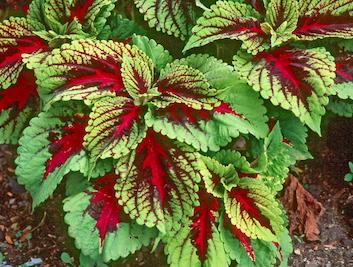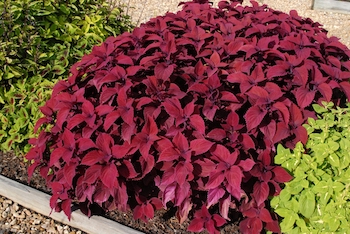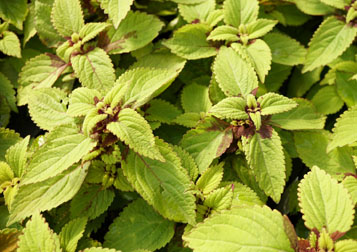Add Colorful Coleus to Your Garden
By Carolyn R. Casey, Fairfax Master Gardener

Kong coleus
Do you enjoy having beautiful and colorful plants in your garden from spring to the first winter freeze? When you talk about adding beauty and color to your garden, most people think about adding colorful flowers. In the spring when you are looking for beautiful and colorful plants, take a minute to look at the colorful coleus (Plectranthus scutellarioides). The genus name comes from the Greek words plectron meaning ‘spur’ and anthos meaning ‘flower’ in reference to the spur-shaped flowers of some members of the genus. Also the genus Scutellaria comes from the Latin word scutella meaning a small dish or saucer in reference to the shape of the persistent calyx after the flowers fade. Its common names are Coleus, Painted Nettle and Trailing Coleus. In recognition of this important plant, the National Public Garden Bureau declared 2015 the Year of the Coleus.
Coleus plants are purchased not because of their flowers but because of their beautiful and colorful foliage that ranges in colors from green, red, burgundy and pink. Coleus plants contain just about all the colors of the spectrum except a true blue. They can be grown in a variety of soils in full sun to part shade. The leaf colors are very intense and vivid, and they look almost like velvet. There are mosaic designs that are common where you see designs of various colors, sometimes along the leaf margins, or major veins or between veins. Some plants may have tiny spots or speckles on their foliage. Also the underside of coleus foliage, petioles and stems may add interest to cultivars by having complementary or contrasting colors to that of the leaves. The foliage of coleus plants comes in a variety of shapes: ovate, oblong and toothed. The stems can be semi-succulent and light green, causing them to stand out from the colorful foliage. In Zone 7, coleus plants are considered annuals or tender perennials when planted outside in your garden. They can also be planted in hanging baskets and containers.

Coleus flower spike
Coleus plants develop flower spikes with small blue or white flowers that are not showy. While the flowers do draw pollinators, they need to be pinched off since this takes the energy from the plant to start seed formation and leads to decline. Also pinching off the flower spikes will help the plant stay compact and bushy. The pinching of your plants will also reduce their height. Coleus plants are native to Southeast Asia and Malaysia. They are tropical evergreen tender perennials that have been prized for their foliage since Victorian times. Coleus plants have square angled stems and opposite leaves that help to identify them as being members of the mint family.
Coleus plants create a 3-foot tall mound as they grow and are erect growing plants requiring little care. They grow one-half to 3 feet tall with a one-half to 3-foot spread. Coleus plants originally needed to be planted in the shade, but today there are new varieties that can be planted in morning sun as long as they have afternoon shade. Some coleus plants like to grow in part shade or dappled light. Also coleus plants that are not tolerant of the sun will bleach and discolor in full sun.

Sun tolerant ‘Redhead’ coleus
There are also new sun tolerant varieties that thrive in full and hot sun. These varieties of coleus can be grown in full sun as long as they do not experience water stress. It is important to keep your coleus plants watered during the heat of summer because they may grow extremely big. An excess amount of sun will cause your coleus plants to become droopy, and too much shade will cause them to become tall and thin. Plants that have light colored foliage like chartreuse may sunburn when they are planted in too much sun while plants with darker colored foliage do better in sunnier places in your garden. Coleus plants enjoy the summer heat.
A coleus needs good drainage, and the soil should be kept moist and not be allowed to dry out. Water your coleus thoroughly when you plant it. During the first 7 to 10 days keep the root ball moist but not too wet. Every three to five days check the soil around your plant and water your plant when the entire top inch is dry. Using mulch around your plant will help to keep the soil moist. You want to water your plant at its base and not wet the foliage. Poorly drained soils and too much watering will cause your coleus to have wet feet leading to stunted growth, brown leaves and scorched leaf margins. When planting your coleus in containers, use a well-drained soil mix and check your plants often since they will be more susceptible to drought. Fertilize your coleus plants in June, July and August using an all-purpose soluble fertilizer that has a formulation like 24-8-16 or 17-4-17. Do not use a fertilizer that is formulated for flower production because the phosphorus will cause the plant to become leggy and to bloom. Did you know that the coleus plant is deer resistant? Some people like to bring their container grown coleus plants indoors before the frost. Check your plants carefully for insects prior to bringing them indoors. Also people may grow the coleus plant as a houseplant. When coleus plants are indoors they need vivid light.

‘Inky Fingers’ coleus
The coleus plant can also be started indoors from seed 8 to 12 weeks before the last frost date. Leave the seeds uncovered and planted in a sterile growing medium at 70 to 75 F. It will take 10 to 15 days to germinate and six to eight weeks before it can be transplanted outdoors into your garden or containers. It is important to pinch off the tips of the shoots before planting in your garden, and this needs to be done if the plant has only a single stem. Use your thumb and finger to pinch off the top one-half inch of the stem and also remove a couple of the top nodes. This will cause your plant to branch out and look fuller in your garden weeks later. Keep in mind that the term ‘plant spread’ refers to how big a plant will be when it is mature.
There are vegetative coleus plants that are sterile, They must be grown from cuttings and require less care than seed grown plants. These coleus plants can be propagated by putting them in potting soil or a glass of water. When you place your cuttings into potting soil it is important to keep them moist and the humidity high until new roots form. Cuttings of your outdoor coleus plants can be done and rooted before frost and grown indoors. Vegetative cultivars can be found in garden centers. These plants offer the greatest variety in foliage colors, leaf size and shape. They are usually found planted in larger pots while the plants in the cell packs have been started from seed.
Planting your coleus plants outdoors in properly prepared beds or containers makes them resistant to most diseases or insect problems. Some potential pests are mealy bugs, aphids and whiteflies. If the foliage happens to get wet while you water your plants or there is excessive moisture in the soil, these can cause your coleus plants to develop downy mildew, stem rot or root rot. Wear gloves when handling coleus plants since you may develop an allergic dermatitis that causes a red rash after repeated and frequent contact with the leaves of the plant. This skin irritation may be minor or last for a few minutes.

‘Pineapple’ coleus
Some of My Favorites
I really enjoy all of the beautiful, unique and colorful coleus plants. It is hard for me to choose one plant over another. I consider the coleus plants with all of their beautiful colors to be a form of eye candy. Here are a few of my favorite sun tolerant plants: ‘Burgundy Sun,’ ‘Chocolate Covered Cherry,’ ‘Pineapple,’ ‘Saturn,’ ‘Solar Sunrise,’ ‘Redhead’ and too many more to name.
Some of my favorite coleus plants that grow in part shade are ‘Black Magic,’ ‘Fishnet Stockings,’ ‘Freckles,’ ‘India Frills,’ ‘Japanese Giant,’ ‘Kong,’ ‘Mardi Gras’ and ‘Red Ruffles,’ to name a few. With such a large selection of colors, shapes and sizes, make your selection based on the area that you want to plant your coleus plants and their needs. When it comes to coleus plants the biggest problem is choosing which foliage colors and shapes you want to add to your garden. Happy gardening with your beautiful and colorful coleus plants!
Resources
• Plectranthus scutellarioides, Missouri Botanical Garden
• Coleus scutellarioides, North Carolina State University Extension Gardener Plant Toolbox
• Coleus, Stephanie Ann Turner, Clemson Cooperative Extension Home and Garden Information Center,
Factsheet HGIC 1162
• Coleus, David Graper, South Dakota State University Extension